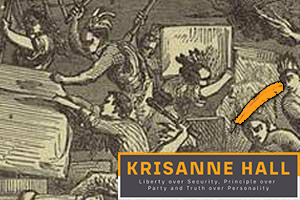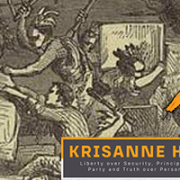The Boston Tea Party- History of Resistance to Government Controls
The Boston Tea Party- History of Resistance to Government Controls
by KrisAnne Hall, JD
257 Years of Resisting Tyranny
I recently anticipated with joy reading a conservative blogger’s attempt to connect the TEA party movement to its historic roots; a topic I have been meaning to write about for months now. The blogger rightly said that the “the historical precedent for today’s Tea Party Movement wasn’t the Tea Party event in Boston Harbor on December 16, 1773.” I actually uttered an “Amen, brother!” He went on to describe the Continental Association established on October 20, 1774 by the First Continental Congress in response to the Intolerable Acts. That’s when I realized that I have waited long enough to write this article.

The fact is the Continental Association of 1774 (10 months after the Boston Tea Party) is about 10 years too late. The first organized opposition to a tyrannical government in the colonies came in 1764 in the form of the Committees of Correspondence. But even that was birthed out of one man taking a stand, against all odds; that man was James Otis, Jr.- his stand was February of 1761.
In 1660, Parliament passed the “Navigation Act” mandating that the American Colonists purchase only government approved goods, manufactured and sold by government approved venders. The justification Parliament used was the need to recoup the debt incurred from the French & Indian War. Alongside this Act, Parliament granted the tax collectors and customs agents the authority to search colonial homes and businesses and seize any goods found that were purchased contrary to the Navigation Act. Parliament authorized these agents to search and seize with unlimited and arbitrary authority, providing no due process protection to ensure the rights of the people were not being abused. This power was authorized under the title of “Writs of Assistance.” This was a violent abuse of the American Colonists’ rights as British subjects. In February of 1761, James Otis, Jr. was the lone wolf and a whistleblower to government power when he challenged the government’s authority in court. From that courtroom Samuel Adams and several other men formed the Committees of Correspondence and the first meeting was held in Boston in 1764. The educated members of the Committees of Correspondence would soon become the Sons of Liberty.
~ For The Details of this History, Go To LibertyFirstSociety.com, enroll & take the “America Disarmed” course!~
In April 1764 Parliament passed the Sugar and Molasses Act. These laws were originally passed in 1733 at the insistence of the large plantation owners in the British West Indies (can you say lobbyists?) The six-pence tax was never successfully collected, and so the Sugar Act actually cut the tax in half but stepped up enforcement. At the same time, the Sugar Act taxed the sugar, coffee, wine, and spices the colonists used, and also regulated the export of lumber and iron. This “excessive taxation and regulation” immediately impaired the colonial economy. In conjunction with the Sugar Act, parliament passed the Currency Act, which essentially assumed control of the colonial monetary system. The Currency Act also established “superior” Vice-admiralty courts to ensure rulings favorable to British interests.
In 1764 the colonies were in the midst of a depressed economy due to the protracted Seven Years’ War, so these indirect taxes and restrictive laws were particularly grievous. In addition to the economic impact, the psychological impact was particularly offensive. The Sugar Act not only restricted the exports by the colonists, but gave an economic “leg up” to the British West Indies. This reinforced the second class status often attributed to the colonists by the British “mainlanders”. The ports of New England were hit especially hard due to the taxes, regulation and government interference. Many of the merchants were in danger of being driven out of the market into bankruptcy.
So in 1764 the first “grass roots” opposition to tyranny in the colonies took shape in the form of a Committee of Correspondence in Boston. The colonists did not have email, smart phones, Facebook or blogs, so the Committees of Correspondence served as a means of communication on issues that needed collective attention. The committee in Boston wrote to other colonies to rally united opposition to the Sugar Act and the Currency Act sparking anti-government protests among the colonists.
On the heels of these protests the Parliament, deciding to clamp down on the rebellious colonists, passed the first Stamp Act and Quartering Act of 1765, and New York formed its Committee of Correspondence to rally resistance to the new taxes and tyranny. Massachusetts Bay committee then sent out letters urging other colonies to send representatives to a Stamp Act Congress in the fall.
As a decade of hostility between the royal government and the colonists rolled on, Boston set up the first Committee with the approval of a town meeting 1764. By spring 1773, patriots decided to follow the Massachusetts system and began to set up their own Committees in each colony. By February 1774, 11 colonies had set up Committees of Correspondence. The Committees would eventually be the basis for the Continental Congress and the Continental Association of 1774. As the revolutionary period unfolded the Committees of Correspondence would become the basis for the future legislative bodies in America. Yet it all began in 1764 as a citizen movement in response to an oppressive government that would not respond to or respect the wishes of the people.
Two of the men behind the movement were Samuel Adams and James Otis Jr.
Mr. Otis was an attorney who had gained notoriety for his pro bono representation of colonial merchants challenging the authority of the Writs of Assistance in 1761. These Writs enabled British authorities to enter any colonist’s home with no advance notice, no probable cause and no reason given. (Today these writs are called national security letters and are authorized under the Patriot Act.) John Adams said of Otis’ five-hour oration in the Boston State House that
“the child independence was then and there born, [for] every man of an immense crowded audience appeared to me to go away as I did, ready to take arms against writs of assistance.”
Also speaking of Otis, John Adams said,
“I have been young and now I am old, and I solemnly say I have never known a man whose love of country was more ardent or sincere, never one who suffered so much, never one whose service for any 10 years of his life were so important and essential to the cause of his country as those of Mr. Otis from 1760 to 1770.”
Better known was Samuel Adams, a representative of the local Boston assembly and member of the Massachusetts House of Representatives. Samuel Adams had this to say in May 1764:
“For if our Trade may be taxed, why not our Lands? Why not the Produce of our Lands & everything we possess or make use of? This we apprehend annihilates our Charter Right to govern & tax ourselves. It strikes at our British privileges, which as we have never forfeited them, we hold in common with our Fellow Subjects who are Natives of Britain. If Taxes are laid upon us in any shape without our having a legal Representation where they are laid, are we not reduced from the Character of free Subjects to the miserable State of tributary Slaves?”
Samuel Adams would later organize the Sons of Liberty which coordinated the famous Boston Tea Party of 1773.
But let’s not forget the ladies of the TEA party movement. Penelope Barker of Edenton, North Carolina organized the Edenton Tea Party in October, 1774. In the home of her friend Elizabeth King, she and 50 other women signed a declaration and sent it to be published in a London newspaper. In part the declaration said:
“Maybe it has only been men who have protested the king up to now. That only means we women have taken too long to let our voices be heard. We are signing our names to a document, not hiding ourselves behind costumes like the men in Boston did at their tea party. The British will know who we are…We, the aforesaid Ladys will not promote ye wear of any manufacturer from England until such time that all acts which tend to enslave our Native country shall be repealed.”
Much like the liberal media of today these principled women were attacked and portrayed by the British as bad mothers and loose women. However, the colonists praised these ladies and the women of the colonies followed their lead and began boycotting British goods.
In light of historical fact, it is clear to any rational and reasonable mind that the modern TEA party movement is not a modern movement at all. The TEA party represents the heart of the American ideal of liberty and self-government. These brave men and women did not sit idly by in the face of oppression and tyranny because they understood their history and knew their rights. They understood that their rights came from God and had been guaranteed to them beginning at the 1100 Charter of Liberties, through the Magna Carter of 1215, and the English Bill of Rights of 1688. Their liberty was not a modern development and neither is ours. That is why, in spite of Rachel Maddow’s pronouncement that the TEA party is over because of small rallies, the TEA party is not going away. It has been here for 247 years and will continue as long as the founding principles of America still burn in the hearts of patriots.



